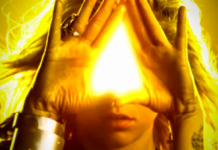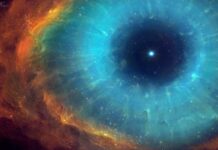The post-Velikovskian Saturnists have made an important contribution to our understanding of ancient astral mythology by highlighting the curious importance that the planet Saturn had in ancient myth and religion.
Velikovsky posited the interesting idea that a major Saturnian event — a nova-like explosion — was witnessed on the Earth, and that watery comets expelled by this event had caused the Great Flood of legend. He also, apparently, dabbled with the idea that Earth had once been, prior to this event, much nearer to Saturn. The Saturnists (beginning with Tresman, but now more conspicuously Talbott, Cardona and Cochrane) have developed this into elaborate models which attempt to explain all world myths in terms of the Earth having once been a satellite of Saturn.
The current Saturnist models run up against a number of problems, in common sense terms. How could the denizens of Earth have survived the separation from Saturn? How could they possibly have tracked and recognised a former sun on its journey to become a tiny star? The MASSIVE upheavals that would have happened during the proposed separation of Earth from Saturn would hardly have provided ideal conditions for observational astronomy. The Saturnists have yet to provide models or explanations for these obvious problems.
From a post-Velikovskian (Clubian) perspective there is another worrying question — are the theories espoused by the Saturnists actually catastrophist? Apart from vague assertions that the break-up of a hypothetical polar configuration occurred in prehistoric times, they have never presented any dated geological, environmental or archaeological evidence for the effects that such a catastrophe would have had on the Earth. Far from providing a catastrophist model, the Saturnists seem to be increasingly settling into a crypto-uniformitarian position.
Recent research in geology and archaeology, post-Velikovsky, has shown that there were indeed many catastrophic events in recent prehistory. To mention a few:
The Allerod conflagration near the end of the Ice Age, as argued by Han Kloosterman, which wiped out the Pleistocene mega-fauna. Though this may be news even to catastrophists, it is almost certain that this brilliant insight will shortly become commonplace in our understanding of the transition to the Holocene.
The catastrophic flooding of the Black Sea during the Neolithic, as argued by the geologist/oceanographer team Ryan and Pitman.
The massive upheavals and climate change which destroyed the Early Bronze Age civilizations of the Near East (c. 2300 BC conventional dating), Mainstream archaeology has now accepted this event, though it yet has to embrace an exoterrestrial cause, such as the cometary debris model long argued by Mandelkehr.
The mini-catastrophe which ended the (Late) Bronze Age with earthquakes and climatic change – discussed by this speaker in Centuries of Darkness (1991) and The Sunken Kingdom (1995), where it was suggested that a Clubian phase of meteorite impact may have been the cause. (Further publication on this research is forthcoming.)
Surely it is recent events like the above, now well documented, which will have shaped the religious beliefs and mythology of mankind which we have inherited. These are the experiences echoed in the sources of the Graeco-Roman period on which the Saturnists rely. The other side of the coin is that the results of genuine catastrophist research – into tangible, datable events – seem to have no place in the Saturnist models, or even be of interest to Saturnist researchers. They rely solely on their readings of ancient myth, all of which is reduced to supposed memories of a polar configuration when the Earth’s axis was aligned with Saturn. Despite its supposed importance, the formation and collapse of the polar configuration have not been linked with any events detectable from Earth sciences or archaeology. The Saturnists theories are therefore not only non-catastrophist but reductionist in the extreme.
Far more economical explanations can be found of the importance of the planet Saturn when we realise that the ancient view of the Solar System — in the time when the texts used by the Saturnists were written — was a basically astrological one. As it happens, a logical explanation of the role played by Saturn in ancient myth can be found which does not involve extravagant remodelling of the solar system. If simpler explanations can be found, then Occams razor cuts out any need for far-fetched Saturnist models. Further, there is clear evidence from the very Golden Age traditions employed by the Saturnists to show that the Solar System was already in its present configuration.
Most of the ancient traditions describing Saturn can be adequately explained in terms of a normal Solar System, and in the light of ancient astrological thinking. However, there remain elements which seem to suggest a catastrophic event. Velikovsky’s original idea, that a catastrophic event on Saturn was visible from the Earth, should be explored further. Fresh thinking needs to be applied to the problem of planetary worship within a Clubian paradigm -comets were surely the main agents of terrestrial catastrophe but we still need to explain how the planets became involved in the ancients fear of the skies as a source of danger.
At a June 1999 catastrophism conference, hosted by Professor Emilio Spedicato at the University of Bergamo in Italy, numerous scholars from diverse fields of study addressed the gathering. Alan Alford, author ofGods Of The New Millennium, for example, gave a lecture on the Nefilim and Anunnaki. Flavio Barbiero (Centro Camuno di Studi Preistorici, Capodiponte, Italia) discussed the possibility that Antarctica could have been the Lost Atlantis. “Abstracts” of each lecture were printed in a program guide, distributed upon registration for the conference. Here is the “abstract” of the lecture given by David Talbott, who is a Kronian Velikovskian “revisionist” and self-appointed expert successor to Dr. Immanuel Velikovsky in terms of “The Saturn Theory” about which David produced a videotape called Remembering The End Of The World. I find it most interesting that David Talbott addressed this conference, but unfortunately he is terribly wrong when he refers to this “planetary object” as Saturn — yet “in general” I think that he makes some very good points in this summary of his lecture.
When you read this “abstract”, think Planet X Nibiru or Cosmic Tree or Night Sun, not the Planet Saturn.
QUOTE
Certain themes of myth occur on every continent. One universal tradition concerns a former Golden Age, a period of cosmic harmony subsequently lost. In the general tradition, the Golden Age means a timeless epoch before the arrival of discord and war, before the linkage of heaven and earth was broken. Many traditions recall the absence of seasons or any time-keeping references, while the land produced abundantly without any need for human labor.
This is a distinctive myth, with crucial connections to other themes. Why did all of the early cultures connect to the Golden Age with the rule of a “king of the world” — a prototype of kings ruling in the sky before a king ever ruled on earth? And why the early astronomical link of this figure to the remote planet Saturn?
Another tradition recalls a “world-ending” disaster, when the Golden Age collapsed and the heavens fell out of control. The specific forms of the catastrophe vary. A rain of fire and gravel, as in the cataclysms of Ragnarok. A great deluge. The death or displacement of a primeval sun. A cloud of chaos demons enshrouding the world in darkness. Or the spiraling serpent or dragon, whose attack throws the heavens into chaos.
But where are the events in our familiar world that can illuminate the repeated stories? A comparative approach will establish that the subject is not a local disaster. Specifically, this archetypal catastrophe — an event whose re-occurrence ancient races feared above all else — was that which brought the Golden Age to its violent conclusion.
The origins of ancient mythology; the birth of the first civilizations; a violent history of the solar system — these are the primary themes of the “Saturn Theory”, a new way of viewing the myth-making epoch as a whole, based on cross-cultural analysis. Astronomers and astrophysicists, historians, anthropologists, archaeologists, and students of ancient myth and religion should reconsider the most common assumptions about ancient history.
The underlying principles of the theory are :
- Major changes in the planetary order, some involving Earth-threatening catastrophes, have occurred within human memory.
- Through myth, ritual and symbol around the world, our ancestors preserved a global record of these tumultuous events.
- The first civilizations arose from ritual practices honoring, imitating, and re-living extraordinary natural occurrences.
- The dominant powers of the ancient rites were planets moving close to the earth.
The planetary model we offer carries one advantage which other theories based on ancient testimony lack. It is specific enough to be falsified on its own ground (ancient testimony). We will propose some simple ground rules permitting researchers to test the hypothesis and draw reliable conclusions.
UNQUOTE
“The Golden Age” ended on 15 June 762 BCE with the departure sequence of “the gods” for their winter’s hibernation at the Oort Cloud.
As I have written elsewhere, David Talbott does not believe in the existence of the Planet X Nibiru because he does not believe in the attendant idea of “ancient astronauts”; and ultimately that is why he cannot see the hidden truth of The Cosmic Tree.
Within the framework of the overall Velikovskian School, moreover, David Talbott’s “theory” is dubious. Dr. Velikovsky explicitly stated that “The Saturn Catastrophe” occurred long before the Israelite Exodus from Egypt and the contemporaneous Santorini Cataclysm, in 1587 BCE. Dr. Velikovsky attributed the cause of this Exodus Catastrophe to “The Birth Of Venus” — the Planet Jupiter ejected a large ball of gas and fire at high speed, and this “comet-like” object grazed the Earth before finally solidifying and stabilizing into its current orbit as the Planet Venus. Well, if Venus did not exist before 1587 BCE, then how could Venus be included in computer animations of “The Saturn Theory” which predated it? It is inherently illogical, and I am surprised that David Talbott didn’t realize that “anomaly” before going to the trouble and expense of producing his slick videotape with all its glitzy computer animations. I noticed his little “chronological discrepancy” immediately.
Sources and read more: http://www.saturn-myth-delusion.net/S…, https://www.youtube.com/watch?v=Rzo-c…
Best Regards
TBU NEWS





